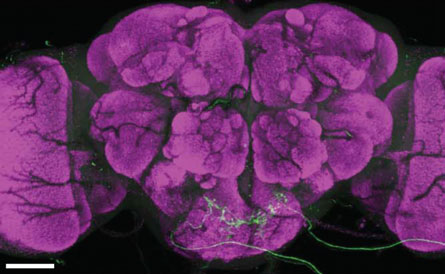- More than 2 years ago
You don’t need to lead a fly to water to make it drink.

A new discovery by neuroscientists helps explain why. Researchers have illuminated the biochemical mechanism that fruit flies use to detect water in their environment.
The finding may lead to a better understanding of how all cells control their water content, and perhaps to similar discoveries in people.
Researchers report online in Nature April 4 that a protein known as PPK28 helps fruit flies taste water.
The protein makes up a channel that spans the membrane of a water-sensing nerve cell in the feeding tube of Drosophila, the fruit fly. PPK28 is from a larger family of channel proteins that includes one mammals use to taste salt. But none had been pegged as a mediator of water flow into cells. It’s possible that related proteins have similar tasks in the cells of mammals, says Charles Bourque of the Centre for Research in Neuroscience at McGill University in Montreal, Canada, who was not involved in the work.
Peter Cameron of the University of California, Berkeley and his colleagues identified the water-sensing role of PPK28 by comparing the genes of normal flies to a group whose taste cells had been transformed into touch sensors.
The genetics pointed to PPK28 as a likely fly divining rod. When the researchers marked the protein with a fluorescent tag and gave the flies various solutions to drink, PPK28 lit up when the flies tasted water, revealing a “drink me” signal that was going right to their brains.
Mutant flies without working PPK28 drank for only about three seconds, versus more than 10 seconds of slurping by normal flies. And when the team turned on PPK28 genes in nerves that usually sense bitter compounds, those nerves then responded to water.
“This is a very beautiful study with a huge amount of detail,” says Nicholas Ryba, head of the Laboratory of Sensory Biology of the National Institutes of Health in Bethesda, Md.
Cells need just the right amount of water — in mammals, too little or too much can lead to nausea, coma, seizures and even death. Animals also need to be able to evaluate whether fluids they place in their mouths have nasty or nutritious things dissolved in them.
“The authors clearly show that the identified protein becomes more active when water purity increases,” Bourque says. This suggests the sensors are well suited to sampling water in the environment, unlike proteins that finely tune water flow inside the body. “These sensors are expressed … precisely where they would allow the fly to assess the nature of the fluid before ingestion,” Bourque says.
While mammals have many ways of controlling the flow of water in and out of cells, there isn’t evidence for a similar mechanism that allows them to “taste” water on the tongue. Maybe, Ryba speculates, that’s because humans have complex nervous systems that allow them to find water in other ways.






